EXERCISE-10.1
P1. Find the perimeter of each of the following figures :
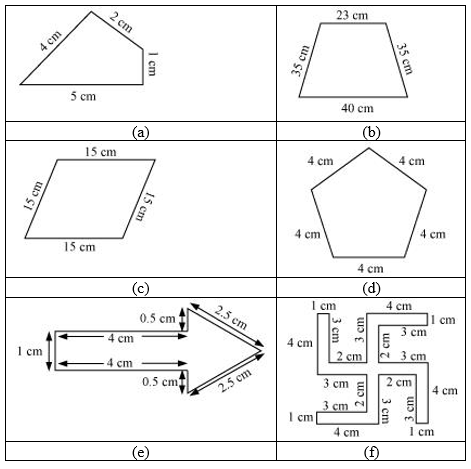
Sol. Perimeter of a polygon is equal to the sum of the lengths of all sides of that polygon.
(a) Perimeter = (4 + 2 +1 + 5) cm = 12 cm
(b) Perimeter = (23 + 35 + 40 + 35) cm = 133 cm
(c) Perimeter = (15 + 15 + 15 + 15) cm = 60 cm
(d) Perimeter = (4 + 4 + 4 + 4 + 4) cm = 20 cm
(e) Perimeter = (1 + 4 + 0.5 + 2.5 + 2.5 + 0.5 + 4) cm = 15 cm
(f) Perimeter = (1 + 3 + 2 + 3 + 4 + 1 + 3 + 2 + 3 + 4 + 1 + 3 + 2 + 3 + 4 + 1 + 3 + 2 + 3 + 4) = 52 cm.
P2. The lid of a rectangular box of sides 40 cm by 10 cm is sealed all round with tape. What is the length of the tape required ?
Sol. Length (l) of rectangular box = 40 cm
Breadth (b) of rectangular box = 10 cm
Length of tape required = Perimeter of rectangular box = 2 (l + b) = 2(40 + 10) = 100 cm
P3. A table-top measures 2 m 25 cm by 1 m 50 cm. What is the perimeter of the table-top ?
Sol. Length (l) of table-top = 2 m 25 cm = 2 + 0.25 = 2.25 m
Breadth (b) of table-top = 1 m 50 cm = 1 + 0.50 = 1 .50 m
Perimeter of table-top = 2 (l + b)
= 2 × (2.25 + 1.50)
= 2 × 3.75 = 7.5 m
P4. What is the length of the wooden strip required to frame a photograph of length and breadth 32 cm and 21 cm respectively ?
Sol. Length (l) of photograph = 32 cm
Breadth (b) of photograph = 21 cm
Length of wooden strip required = Perimeter of Photograph = 2 × (l + b)
= 2 × (32 + 21) = 2 × 53 = 106 cm
P5. A rectangular piece of land measures 0.7 km by 0.5 km. Each side is to be fenced with 4 rows of wires. What is the length of the wire needed ?
Sol. Length (l) of land = 0.7 km
Breadth (b) of land = 0.5 km
Perimeter = 2 × (l + b) = 2 × (0.7 + 0.5) = 2 × 1.2 = 2.4 km
Length of wire required = 4 × 2.4 = 9.6 km
P6. Find the perimeter of each of the following shapes :
(a) A triangle of sides 3 cm, 4 cm and 5 cm.
(b) An equilateral triangle of side 9 cm.
(c) An isosceles triangle with equal sides 8 cm each and third side 6 cm.
Sol. (a) Perimeter = (3 + 4 + 5) cm = 12 cm
(b) Perimeter of an equilateral triangle = 3 × Side of triangle = (3 × 9) cm = 27 cm
(c) Perimeter = (2 × 8) + 6 = 22 cm
P7. Find the perimeter of a triangle with sides measuring 10 cm, 14 cm and 15 cm.
Sol. Perimeter of triangle = Sum of the lengths of all sides of the triangle
Perimeter = 10 + 14 + 15 = 39 cm
P8. Find the perimeter of a regular hexagon with each side measuring 8 m.
Sol. Perimeter of regular hexagon = 6 × Side of regular hexagon
Perimeter of regular hexagon = 6 × 8 = 48 m
P9. Find the side of the square whose perimeter is 20 m.
Sol. Perimeter of square = 4 × Side
20 = 4 × Side
Side = .
P10. The perimeter of a regular pentagon is 100 cm. How long is its each side ?
Sol. Perimeter of regular pentagon = 5 × Length of side
100 = 5 × Side
Side = = 20 cm
P11. A piece of string is 30 cm long. What will be the length of each side if the string is used to form :
(a) a square ?
(b) an equilateral triangle ?
(c) a regular hexagon ?
Sol. (a) Perimeter = 4 × Side
30 = 4 × Side
Side =
(b) Perimeter = 3 × Side
30 = 3 × Side
Side =
(c) Perimeter = 6 × Side
30 = 6 × Side
Side =
P12. Two sides of a triangle are 12 cm and 14 cm. The perimeter of the triangle is 36 cm. What is its third side ?
Sol. Perimeter of triangle = Sum of all sides of the triangle
36 = 12 + 14 + Side
36 = 26 + Side
Side = 36 − 26 = 10 cm
Hence, the third side of the triangle is 10 cm.
P13. Find the cost of fencing a square park of side 250 m at the rate of Rs 20 per metre.
Sol. Length of fence required = Perimeter of the square park
= 4 × Side
= 4 × 250 = 1000 m
Cost for fencing 1 m of square park = Rs 20
Cost for fencing 1000 m of square park = 1000 × 20 = Rs 20000
P14. Find the cost of fencing a rectangular park of length 175 m and breadth 125 m at the rate of Rs 12 per metre.
Sol. Length (l) of rectangular park = 175 m
Breadth (b) of rectangular park = 125 m
Length of wire required for fencing the park = Perimeter of the park
= 2 × (l + b)
= 2 × (175 + 125)
= 2 × 300
= 600 m
Cost for fencing 1 m of the park = Rs 12
Cost for fencing 600 m of the square park = 600 × 12 = Rs 7200
P15. Sweety runs around a square park of side 75 m. Bulbul runs around a rectangular park with length 60 m and breadth 45 m. Who covers less distance ?
Sol. Distance covered by Sweety = 4 × Side of square park = 4 × 75 = 300 m
Distance covered by Bulbul = 2 × (60 + 45) = 2 × 105 = 210 m
Therefore, Bulbul covers less distance.
P16. What is the perimeter of each of the following figures? What do you infer from the answers ?
(a) 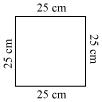
(b) 
(c) 
(d) 
Sol. (a) Perimeter of square = 4 × 25 = 100 cm
(b) Perimeter of rectangle = 2 × (10 + 40) = 100 cm
(c) Perimeter of rectangle = 2 × (20 + 30) = 100 cm
(d) Perimeter of triangle = 30 + 30 + 40 = 100 cm
It can be inferred that all the figures have the same perimeter.
P17. Avneet buys 9 square paving slabs, each with a side of m. He lays them in the form of a square.
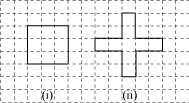
(a) What is the perimeter of his arrangement [figure (i)] ?
(b) Shari does not like his arrangement. She gets him to lay them out like a cross. What is the perimeter of her arrangement [figure (ii)] ?
(c) Which has greater perimeter?
(d) Avneet wonders if there is a way of getting an even greater perimeter. Can you find a way of doing this? (The paving slabs must meet along complete edges i.e. they cannot be broken.)
Sol. (a) Side of square =
Perimeter of square =
(b) Perimeter of cross = 0.5 + 1 + 1 + 0.5 + 1 + 1 + 0.5 + 1 + 1+ 0.5 + 1 + 1 = 10 m

(c) The arrangement in the form of a cross has a greater perimeter.
(d) Arrangements with perimeters greater than 10 m cannot be determined.
EXERCISE-10.2
P1.Find the areas of the following figures by counting square :

Sol. (a) The figure contains 9 fully filled squares only. Therefore, the area of this figure will be 9 square units.
(b) The figure contains 5 fully filled squares only. Therefore, the area of this figure will be 5 square units.
(c) The figure contains 2 fully filled squares and 4 half-filled squares. Therefore, the area of this figure will be 4 square units.
(d) The figure contains 8 fully filled squares only. Therefore, the area of this figure will be 8 square units.
(e) The figure contains 10 fully filled squares only. Therefore, the area of this figure will be 10 square units.
(f) The figure contains 2 fully filled squares and 4 half-filled squares. Therefore, the area of this figure will be 4 square units.
(g) The figure contains 4 fully filled squares and 4 half-filled squares. Therefore, the area of this figure will be 6 square units.
(h) The figure contains 5 fully filled squares only. Therefore, the area of this figure will be 5 square units.
(i) The figure contains 9 fully filled squares only. Therefore, the area of this figure will be 9 square units.
(j) The figure contains 2 fully filled squares and 4 half-filled squares. Therefore, the area of this figure will be 4 square units.
(k) The figure contains 4 fully filled squares and 2 half-filled squares. Therefore, the area of this figure will be 5 square units.
(l) From the given figure, it can be observed that,
|
Covered Area |
Number |
Area estimate (sq units) |
|
Fully filled squares |
2 |
2 |
|
Half filled squares |
− |
− |
|
More than half – filled squares |
6 |
6 |
|
Less than half – filled squares |
6 |
0 |
Total area = 2 + 6 = 8 square units
(m) From the given figure, it can be observed that,
|
Covered Area |
Number |
Area estimate (sq units) |
|
Fully filled squares |
5 |
5 |
|
Half-filled squares |
− |
− |
|
More than half-filled squares |
9 |
9 |
|
Less than half-filled squares |
12 |
0 |
Total area = 5 + 9 = 14 square units
(n) From the given figure, it can be observed that,
|
Covered Area |
Number |
Area estimate (sq units) |
|
Fully filled squares |
8 |
8 |
|
Half-filled squares |
− |
− |
|
More than half-filled squares |
10 |
10 |
|
Less than half-filled squares |
9 |
0 |
Total area = 8 + 10 = 18 square units.
EXERCISE-10.3
P1. Find the areas of the rectangles whose sides are:
(a) 3 cm and 4 cm
(b) 12 m and 21 m
(c) 2 km and 3 km
(d) 2 m and 70 cm
Sol. It is known that,
Area of rectangle = Length × Breadth
(a) l = 3 cm; b = 4 cm
Area = l × b = 3 × 4 = 12 cm2
(b) l = 12 m; b = 21 m
Area = l × b = 12 × 21 = 252 m2
(c) l = 2 km ; b = 3 km
Area = l × b = 2 × 3 = 6 km2
(d) l = 2 m; b = 70 cm = 0.70 m
Area = l × b = 2 × 0.70 = 1.40 m2
P2. Find the areas of the squares whose sides are :
(a) 10 cm
(b) 14 cm
(c) 5 m
Sol. It is known that,
Area of square = (Side)2
(a) Side = 10 cm
Area = (10)2 =100 cm2
(b) Side = 14 cm
Area = (14)2 = 196 cm2
(c) Side = 5 m
Area = (5)2 = 25 m2
P3. The length and breadth of three rectangles are as given below :
(a) 9 m and 6 m
(b) 17 m and 3 m
(c) 4 m and 14 m
Which one has the largest area and which one has the smallest ?
Sol. It is known that,
Area of rectangle = Length × Breadth
(a) l = 9 m; b = 6 m
Area = l × b = 9 × 6 = 54 m2
(b) l = 17 m; b = 3 m
Area = l × b = 17 × 3 = 51 m2
(c) l = 4 m; b = 14 m
Area = l × b = 4 × 14 = 56 m2
It can be seen that rectangle (c) has the largest area and rectangle (b) has the smallest area.
P4. The area of a rectangular garden 50 m long is 300 sq m. Find the width of the garden.
Sol. Let the breadth of the rectangular garden be b.
l = 50 m
Area = l × b = 300 square m
50 × b = 300
P5. What is the cost of tiling a rectangular plot of land 500 m long and 200 m wide at the rate of Rs 8 per hundred sq m ?
Sol. Area of rectangular plot = 500 × 200 = 100000 m2
Cost of tiling per 100 m2 = Rs 8
Cost of tiling per 100000 m2 = = Rs 8000
P6. A table-top measures 2 m by 1 m 50 cm. What is its area in square metres ?
Sol. Length (l) = 2 m
Breadth (b) = 1 m 50 cm =
Area = l × b = 2 × 1.5 = 3 m2
P7. A room is 4 m long and 3 m 50 cm wide. How many square metres of carpet is needed to cover the floor of the room ?
Sol. Length (l) = 4 m
Breadth (b) = 3 m 50 cm = 3.5 m
Area = l × b = 4 × 3.5 = 14 m2
P8. A floor is 5 m long and 4 m wide. A square carpet of sides 3 m is laid on the floor. Find the area of the floor that is not carpeted.
Sol. Length (l) = 5 m
Breadth (b) = 4 m
Area of floor = l × b = 5 × 4 = 20 m2
Area covered by the carpet = (Side)2 = (3)2 = 9 m2
Area not covered by the carpet = 20 − 9 = 11 m2
P9. Five square flower beds each of sides 1 m are dug on a piece of land 5 m long and 4 m wide. What is the area of the remaining part of the land ?
Sol. Area of the land = 5 × 4 = 20 m2
Area occupied by 5 flower beds = 5 × (Side)2 = 5 × (1)2 = 5 m2
Area of the remaining part = 20 − 5 = 15 m2
P10. By splitting the following figures into rectangles, find their areas (The measures are given in centimetres).
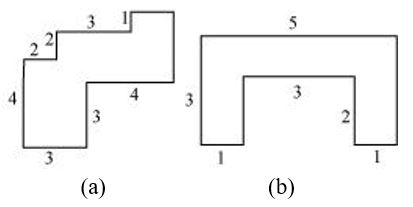
Sol.
(a) The given figure can be broken into rectangles as follows.

Area of 1st rectangle = 4 × 2 = 8 cm2
Area of 2nd rectangle = 6 × 1 = 6 cm2
Area of 3rd rectangle = 3 × 2 = 6 cm2
Area of 4th rectangle = 4 × 2 = 8 cm2
Total area of the complete figure = 8 + 6 + 6 + 8 = 28 cm2
(b) The given figure can be broken into rectangles as follows.

Area of 1st rectangle = 3 × 1 = 3 cm2
Area of 2nd rectangle = 3 × 1 = 3 cm2
Area of 3rd rectangle = 3 × 1 = 3 cm2
Total area of the complete figure = 3 + 3 + 3 = 9 cm2
P11. Split the following shapes into rectangles and find their areas. (The measures are given in centimetres)
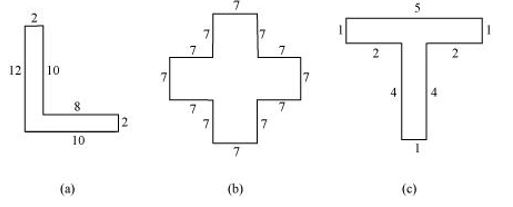
Sol. (a) The given figure can be broken into rectangles as follows.

Area of 1st rectangle = 12 × 2 = 24 cm2
Area of 2nd rectangle = 8 × 2 = 16 cm2
Total area of the complete figure = 24 + 16 = 40 cm2
(b) The given figure can be broken into rectangles as follows.

Area of 1st rectangle = 21 × 7 = 147 cm2
Area of 2nd square = 7 × 7 = 49 cm2
Area of 3rd square = 7 × 7 = 49 cm2
Total area of the complete figure = 147 + 49 + 49 = 245 cm2
(c) The given figure can be broken into rectangles as follows.

Area of 1st rectangle = 5 × 1 = 5 cm2
Area of 2nd rectangle = 4 × 1 = 4 cm2
Total area of the complete figure = 5 + 4 = 9 cm2
P12. How many tiles whose length and breadth are 12 cm and 5 cm respectively will be needed to fit in a rectangular region whose length and breadth are respectively :
(a) 100 cm and 144 cm
(b) 70 cm and 36 cm
Sol. (a) Total area of the region = 100 × 144 = 14400 cm2
Area of one tile = 12 × 5 = 60 cm2
Number of tiles required =
Therefore, 240 tiles are required.
(b) Total area of the region = 70 × 36 = 2520 cm2
Area of one tile = 60 cm2
Number of tiles required =
Therefore, 42 tiles are required.








